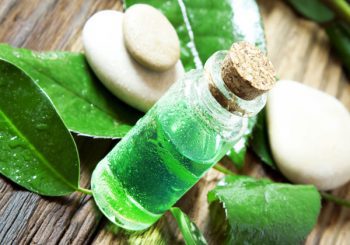Contributing writer for Wake Up World
Tea tree oil is considered to be one of the most versatile essential oils. While it has a long history of use for the treatment of skin conditions and wounds, you may appreciate this pungent oil most when you have an unsightly cold sore or bothersome wart. Given its many uses for health and home, I highly recommend tea tree oil.
[pro_ad_display_adzone id=”110028″]
What Is Tea Tree Oil?
Tea tree oil, also known as melaleuca oil, is extracted from the leaves of the tea tree plant (Melaleuca alternifolia), a member of the myrtle tree family, which is native to Australia and New Zealand. The name was coined by British explorer Capt. James Cook in the 1770s when he saw native Australians brewing tea using leaves from the tree.1
The tea tree was highly prized by primitive Australian communities for its unique healing ability. With regard to some of tea tree’s uses, The Australian Tea Tree Industry Association states:2
“The indigenous Bundjalung people of eastern Australia are believed to have used tea trees as a traditional medicine for many years in a variety of ways, including inhaling the oil from the crushed leaves to treat coughs and colds and applying the leaves on wounds as a poultice, as well as brewing an infusion of the leaves to make a tea for [the] treatment of sore throats, or applying [it] on the skin for minor wounds, abrasions and insect bites and stings.”
It was only in the 1920s and 1930s that tea tree oil’s medicinal properties became more widely known, thanks to the efforts of researcher Arthur Penfold, an Australian state government chemist, who published a series of papers on the oil’s antimicrobial properties.3 He rated it as 11 times more active than phenol. The author of a 2012 review on tea tree oil stated:4
“The commercial tea tree oil industry was born after the medicinal properties of the oil were first reported by Penfold. Production ebbed after World War II, as demand for the oil declined, presumably due to the development of effective antibiotics and the waning image of natural products.
Interest in the oil was rekindled in the 1970s as part of the general renaissance of interest in natural products. Commercial plantations were established in the 1970s and 1980s, which led to mechanization and large-scale production of a consistent essential oil product.”
Tea tree oil contains more than 100 components, but it is mostly made up of terpene hydrocarbons: monoterpenes, sesquiterpenes and their alcohols.5 Through modern distillation methods, manufacturers are able to produce tea tree oil with a clear to very pale golden or yellow color, and a camphor-like scent.6
Tea Tree Oil Works Wonders on Cold Sores
Authors of lab-based experiments performed by a research arm of the Australian government found tea tree oil to be effective in the treatment of cold sores. They concluded:7
“TTO (tea tree oil) may be a potentially useful alternative treatment for cold sores which is relatively inexpensive, acceptable to patients and which does not have the capacity to induce resistance to systemic antiviral agents. A larger study is required to further evaluate TTO as a topical treatment for RHL [recurrent herpes labialis, also known as cold sores].”
Research published in the Journal of Antimicrobial Chemotherapy8 indicates tea tree oil has shown broad-spectrum antimicrobial activity in vitro, including activity against herpes simplex virus (HSV), the etiological agent of RHL. In this research, patients aged 18 to 70 years participated in a randomized, placebo-controlled study.
Participants presented as soon as possible after onset of a cold sore outbreak and were randomized to receive either 6% tea tree oil in an aqueous gel base or a placebo gel, both of which were applied five times daily. The median time to re-epithelialization after treatment with tea tree oil was nine days, compared with 12.5 days for the placebo group.
The study authors stated, “Tea tree oil may be a potentially useful cheaper alternative, acceptable to patients and which poses little threat of inducing resistance to systemic antiviral agents.”9
A study published in the journal Microbiology and Immunology10 evaluated the impact of 12 essential oils, including tea tree oil, on HSV type-1 (HSV-1) in vitro. The researchers noted tea tree oil had previously been shown to have antiviral activity against HSV-1 and HSV-2, along with eucalyptus essential oil. They said:11
“It is well-known that TTO has strong antibacterial, antiviral and antifungal activity. The antiviral activity of tea tree against HSV-1 and -2 has been reported; however, the results in the present study demonstrated that because tea tree possessed antiviral activity against HSV-1 at a concentration of 1%, but not at a concentration of 0.1%, lemongrass showed the stronger antiviral activity than tea tree.”
As you can see, when it comes to treating cold sores, you have more than one option when applying essential oils. The good news is, if you have a sensitivity to tea tree oil, you might also try either eucalyptus essential oil or lemongrass essential oil. The video above provides a couple of additional ideas on how to treat cold sores naturally.
Use Tea Tree Oil to Remove Warts
Warts come in all shapes and sizes, and tea tree oil has been shown to be effective in treating warts found on the genitals, hands and feet. The treatment for each type of wart is similar: Simply apply one drop of tea tree oil to a cotton ball and press it over the wart.
If desired, you can apply a bandage or piece of tape over the cotton ball to keep it in place. Clean the area well and repeat the oil treatment daily until the wart disappears — usually in one to four weeks. Alternately, you can apply a drop of tea tree oil directly to the affected area once daily until the condition improves.
Research published in the journal Complementary Therapies in Clinical Practice12 highlights the successful topical treatment of hand warts for pediatric patients using tea tree oil.
The oil was applied directly to the lesions once a day for 12 days. The study authors commented, “The case highlights the potential use of tea tree oil in the treatment of common warts due to human papilloma virus.”13
25 Other Uses for Tea Tree Oil
Tea tree oil has been long valued for its antifungal, antibacterial and antiviral properties. It was first used in dentistry and surgery to help clean wounds and prevent infections in the 1920s and during World War II to treat skin injuries suffered by people working in munition factories.14
More recently, tea tree oil has been added to lotions, shampoos and soaps. Below are 25 anecdotal uses for this versatile oil:15,16
| Acne treatment — Add a drop of this oil to your normal cleansing routine or dab a very small amount on acne breakouts to soothe and disinfect the area |
| All-purpose cleaner and disinfectant — Add one drop of this oil to a cup of water and put it in a spray bottle for use as an all-purpose natural cleaner in your bathroom and kitchen; works well on most surfaces, including ceramic, linoleum, porcelain and stone |
| Bad breath — Add one drop of oil to 1 ounce of water and use as a gargle; do not swallow! |
| Bladder infection — Mix 10 to 15 drops of tea tree oil into 1 cup of Epsom salts and add to a shallow bath; soak for 10 minutes and then wash the area well with soap and water |
| Boils — Wet and apply a warm washcloth for a few minutes and then apply a drop or two of tea tree oil to the area, which should cause the infection to surface and be released |
| Bronchitis — Use for steam inhalation by adding 1 to 2 drops of tea tree oil to a pot of boiled water or massage the oil directly over your chest |
| Dandruff — Add 20 to 30 drops of tea tree oil to your regular shampoo or massage a few drops directly into your scalp after washing |
| Dermatitis — Add 10 drops of oil to 1 tablespoon of a carrier oil and massage into the affected areas two to three times a day until the condition improves |
| Gout — Add 10 drops of tea tree oil to 2 tablespoons of a carrier oil and massage into the affected area two to three times a day |
| Head lice — Add 20 drops of oil to 2 tablespoons of shampoo and massage into your scalp and hair; leave on for 10 minutes and then rinse. Repeat three to four times a day until the eggs are gone |
| Immune booster — Add a few drops of tea tree oil to a diffuser and diffuse it into the air or apply 1 to 2 drops to the bottoms of your feet and massage into the skin |
| Inflammation — Massage over any inflamed areas using gentle, gliding strokes directed toward your heart |
| Jock itch — Apply 10 to 15 drops of tea tree oil to 2 tablespoons of a carrier oil and apply to affected area twice daily; dust with cornstarch to reduce chafing |
| Laundry freshener — Adding a few drops of tea tree oil during the wash cycle will not only make your laundry smell fresher, but will also kill organisms lurking in your washer |
| Mosquito bites — Apply one drop of oil directly to bites and repeat daily as needed |
| Muscle aches and pains — Add 10 to 15 drops of oil to one-half cup Epsom salts, and dissolve in bath. Add 10 drops of oil to 2 tablespoons of carrier oil. Massage well |
| Natural pest control — The strong smell of tea tree oil naturally repels ants and other insects, as well as moths. Make a natural insect repellent by mixing a few drops of tea tree oil with coconut oil or put cotton balls soaked in tea tree oil in bins of stored clothing |
| Sinusitis — Use as directed for bronchitis or use as a sinus rinse by adding two drops to a neti pot |
| Sports equipment deodorizer — Remove funky smells and bacteria from sports gear by spritzing it with the same spray formulation noted above for all-purpose cleaning and disinfecting |
| Stain remover — Mix a couple drops of tea tree oil with salt or baking soda to create a gentle abrasive cleaner that is great for removing stubborn stains |
| Sunburn — Mix one drop of tea tree oil with 1 tablespoon of coconut oil and one drop of lavender; gently apply to sunburn-affected areas at least twice a day |
| Tattoos — Apply a few drops of tea tree oil directly to newly applied tattoos to prevent infection, or mix with a carrier oil first and then apply |
| Toenail fungus — Add one to two drops of tea tree oil directly to the affected nail and surrounding tissue; repeat morning and evening until the condition improves |
| Toothbrush cleaner — Use one drop to disinfect your toothbrush, a known breeding ground for mold and bacteria |
| Wound care — For minor cuts and abrasions, clean the area well and then apply a few drops of the oil directly to the affected area; use the same treatment for blisters |
Adverse Reactions to Tea Tree Oil Are Relatively Uncommon
Undiluted tea tree oil has been known to cause skin irritation in some people, but the risk is considered low.
Authors of a 2003 study,17 involving 311 participants treated with undiluted and diluted formulations of tea tree oil, said, “Topical application of tea tree oil is associated with negligible skin irritancy. In the group of subjects studied, the risk of developing an allergic dermatitis from topical tea tree oil usage was found to be less than 1%.”18
That said, they also noted three subjects developed a grade 3 skin reaction when tea tree oil was applied, which is suggestive of an allergic reaction. As with all essential oils, I recommend you perform a patch test as a first step to determining if your body may have a sensitivity to tea tree oil.
Simply apply one drop to the underside of your forearm and wait 24 hours. If your skin breaks out or you have other unexplained symptoms, do not use the oil. Keep in mind that tea tree oil can be toxic when ingested in larger amounts so never use this oil orally, and do not swallow any homemade preparations containing tea tree oil.
Sources and References:
- 1, 2 Australian Tea Tree Industry Association November 5, 2015
- 3, 4 International Journal of Bioinformatics and Biological Science March 2013; 1(1): 71-77 [PDF]
- 5 Clinical Microbiology Reviews January 2006; 19(1): 50–56 [PDF]
- 6 ABC-AHP-NCNPR Botanical Adulterants Prevention Program. 2018
- 7 Australian Rural Industries Research and Development Corporation August 2005 [PDF]
- 8, 9 Journal of Antimicrobial Chemotherapy September 1, 2001; 48(3): 450–451
- 10, 11 Microbiology and Immunology 2003; 47(9): 681-684 [PDF]
- 12, 13 Complementary Therapies in Clinical Practice November 2008; 14(4): 225-227
- 14 Drugs.com June 7, 2018
- 15 Mother Nature Network February 24, 2014
- 16 ActivistPost.com May 21, 2013
- 17, 18 Exogenous Dermatology 2003; 2: 258–261
About the author:
Born and raised in the inner city of Chicago, IL, Dr. Joseph Mercola is an osteopathic physician trained in both traditional and natural medicine. Board-certified in family medicine, Dr. Mercola served as the chairman of the family medicine department at St. Alexius Medical Center for five years, and in 2012 was granted fellowship status by the American College of Nutrition (ACN).
While in practice in the late 80s, Dr. Mercola realized the drugs he was prescribing to chronically ill patients were not working. By the early 90s, he began exploring the world of natural medicine, and soon changed the way he practiced medicine.
In 1997 Dr. Mercola founded Mercola.com, which is now routinely among the top 10 health sites on the internet. His passion is to transform the traditional medical paradigm in the United States. “The existing medical establishment is responsible for killing and permanently injuring millions of Americans… You want practical health solutions without the hype, and that’s what I offer.”
Visit Mercola.com for more information, or read Dr. Mercola’s full bio and resumé here.
[pro_ad_display_adzone id=”110027″]








